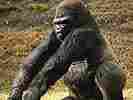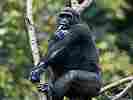
gorillas
Wild Animals
alligators
baboons
bears
chimpanzees
crocodiles
deer
dolphins
elephants
foxes
giraffes
gorillas
leopards
lions
seals
sharks
snakes
tigers
whales
wolves
zebras
Pets
dogs
cats
fish
birds
|
This site provides you with the information about gorillas, gorilla information online, gorilla pictures online, gorilla photos, gorilla pics for kids, images of gorillas, gorilla description, free gorilla info, and more.
If you think that this site is helpful, please recommend your friends to visit our site.
gorillas
I INTRODUCTION
Gorilla, largest, rarest, and most powerful ape. Gorillas inhabit the forests of equatorial Africa from the western lowlands near the Cameroon coast to an altitude of about 3000 m (about 10,000 ft) in the central highlands of the Democratic Republic of the Congo (DRC, formerly Zaire) and Uganda. Three geographically distinct types are recognized: the western lowland gorilla, the eastern lowland gorilla, and the more densely coated mountain gorilla.
II PHYSICAL CHARACTERISTICS
The male gorilla may attain a height of 1.7 m (5.5 ft) and a weight of about 180 kg (about 400 lb) in its natural surroundings. It is several centimeters taller and much fatter in captivity. The female can reach a height of 1.52 m (5 ft), but can be about 30 cm (about 12 in) shorter and half the weight of the male. The skin of the gorilla is black, and the hair is coarse and near-black, turning gray on the backs of old males (hence called silverbacks). The muzzle is short and hairless, with a flat nose, flaring nostrils, and strong jaws. The eyes and ears are small, and the brow ridge is prominent. The brain case and bulk are smaller than in humans. The skeletal structure of the gorilla is similar to that of humans, but the bones are thicker, the arms much longer, and the legs shorter. The spine lacks the curvatures for a sustained erect posture; thus, while the animal frequently stands upright and walks erect for short periods by grasping at tree branches or other support, it more often moves about in a stooped position, using the knuckles of the hands to bear part of its weight.
III BEHAVIOR
Little was known about the life of gorillas in the wild until the publication of The Mountain gorillas: Ecology and Behavior (1963), a pioneering study by the American zoologist George B. Schaller, who observed the animals for several years. His work was followed by that of another American zoologist, Dian Fossey, who studied and lived among the mountain gorillas from 1963 until her death in 1985 at the Karisoke Research Center, which she had established in Rwanda in 1967. Gorillas, contrary to legend, were found to be shy and amiable creatures, usually living in groups of 5 to 15. A typical band includes a silverback, 1 or 2 subdominant males, several mature females, and young. Most of the young males are driven out at maturity and may form all-male groups or loosely attach themselves to other bands. A silverback defeated by a male challenger thereafter leads a solitary life.
Gorillas build makeshift camps each night after a day of foraging for the succulent plants, berries, and leaves that constitute their diet. At times the females and young sleep in trees on platforms made of small branches and leaves, while the older males nest on drier grass at the base of the tree. A hooting sound is uttered as an alarm signal or to note any unusual event; when the male leader uses it, the entire group is instantly attentive. Other calls include sharp grunts for invoking discipline and low growls for expressing pleasure. All gorillas beat their chests; in the male this behavior may serve as a display of power or intimidation. The gorilla has no natural enemies, but the male leader will charge all intruders while the females and young flee to a safe distance. Intruders who run away may be chased and killed; those who stand their ground are not harmed.
The sexual cycle in the gorilla is the same as in the human. The female menstruates about every 28 days and may mate in any season. Single or, occasionally, twin young are born after about 8.5 months. Young are suckled for about a year and mature at 11 to 12 years. Gorillas in the wild live on average into their thirties; in captivity, they live into their mid-forties.
IV INTELLIGENCE
The mental capacity of the gorilla is still being explored. Not as curious or excitable as its nearest relative, the chimpanzee, the gorilla shows more persistence and memory retention in solving a problem and is more likely to perform a task out of interest than to earn a reward. It also discriminates between geometrical shapes more effectively. After some success with chimpanzees, researchers in the mid-1970s turned their attention to communicating with gorillas by means of the American sign language, and one gorilla, Koko, mastered more than 1000 signs.
VENDANGERED STATUS Gorillas are now considered to be in danger of extinction because of encroachment on their habitat and continued hunting.
Scientific classification: Gorillas belong to the family Pongidae. They are classified as Gorilla gorilla. The western lowland subspecies is classified as Gorilla gorilla gorilla, the eastern lowland subspecies as Gorilla gorilla graueri, and the mountain subspecies as Gorilla gorilla beringei.




|